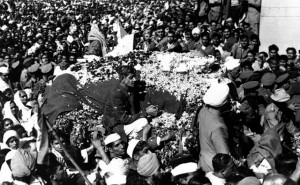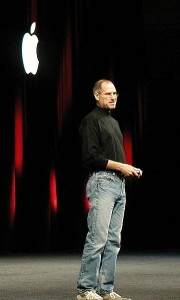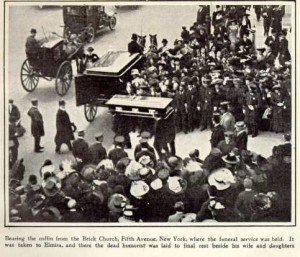Famous Funerals to Inspire Us
April 1, 2016Whether it is a funeral procession for a head of state attended by many thousands, a private service for a high-tech visionary, or a nation in mourning for a beloved literary figure, the eulogies, tributes, viewings and outpouring of love and devotion from these famous funerals can inspire us all.
A Man of Peace: Throngs Mourn
 “The light has gone out, I said, and yet I was wrong. For the light that shone in this country was no ordinary light. The light that has illumined this country for these many years will illumine this country for many more years, and a thousand years later; that light will be seen in this country, and the world will see it, and it will give solace to innumerable hearts. For that light represented something more than the immediate past – it represented the living, the eternal truths, reminding us of the right path, drawing us from error, taking this ancient country to freedom.”
“The light has gone out, I said, and yet I was wrong. For the light that shone in this country was no ordinary light. The light that has illumined this country for these many years will illumine this country for many more years, and a thousand years later; that light will be seen in this country, and the world will see it, and it will give solace to innumerable hearts. For that light represented something more than the immediate past – it represented the living, the eternal truths, reminding us of the right path, drawing us from error, taking this ancient country to freedom.”
These were the words of Jawaharlal Nehru, the first prime minister of the modern state of India, delivered extemporaneously in a nationwide radio broadcast on January 30, 1948, following the assassination of 78-year-old Mohandas “Mahatma” Gandhi earlier that day. Prime Minister Nehru’s eulogy was spoken from the heart in an attempt to bring healing to himself and to a nation of mourners. His speech not only honored Gandhi but also inspired others to follow Gandhi’s non-violent ways rather than succumb to anger and violence.
Nehru’s speech continued with a plea for mourners to offer their prayers for their fallen leader at the river or the sea during the appointed time for Gandhi’s cremation the following afternoon: “And while we pray, the greatest prayer that we can offer is to take a pledge to dedicate ourselves to the truth, and to the cause for which this great countryman of ours lived and for which he has died. That is the best prayer that we can offer him and his memory. That is the best prayer we can offer to India and ourselves.”
Gandhi’s body was laid out in state at Birla House, a house of prayer in New Delhi where the assassination took place, and was draped in a white Khadar sheet surrounded by flower petals. Members of his family and ashram gathered around his body while a Sikh priest recited prayers. The funeral procession left from Birla House toward the banks of the river Jumna where the cremation took place.
The funeral route was thronged with nearly a million people, both Hindus and Muslims, to pay tribute to the Indian statesman as it wound its way to the site of the cremation. Vast crowds witnessed the burning of the funeral pyre. Gandhi’s ashes were collected at the funeral and then carried through the streets of Allahabad, one of India’s holiest cities in the north, before being scattered in the Ganges River.
This public funeral and cremation allowed an entire nation to mourn and pray for a man who had guided them toward freedom and peace.
A Modern Visionary: High-tech farewell
 Apple Co-founder Steve Jobs was a visionary and a leader in cutting edge technology. In public, he brought the world of computing to the personal level, including laptop computers and smart phones. But Jobs was guarded about his personal life, so it was fitting to have a small, private funeral and burial in a non-denominational cemetery in Palo Alto two days after his death followed by an invitation-only memorial service and reception a week later. Jobs died on Oct. 5, 2011 at 56-years-old from a long battle with pancreatic cancer. The memorial service held Sunday, Oct. 16 at Stamford University’s Memorial Church was attended by hundreds of mourners, including celebrities such as Joan Baez, who dated Jobs at one time, and business competitors such as Bill Gates, founder of Microsoft, and Dell CEO Michael Dell. Then Governor of California Jerry Brown declared October 16 as “Steve Jobs Day.”
Apple Co-founder Steve Jobs was a visionary and a leader in cutting edge technology. In public, he brought the world of computing to the personal level, including laptop computers and smart phones. But Jobs was guarded about his personal life, so it was fitting to have a small, private funeral and burial in a non-denominational cemetery in Palo Alto two days after his death followed by an invitation-only memorial service and reception a week later. Jobs died on Oct. 5, 2011 at 56-years-old from a long battle with pancreatic cancer. The memorial service held Sunday, Oct. 16 at Stamford University’s Memorial Church was attended by hundreds of mourners, including celebrities such as Joan Baez, who dated Jobs at one time, and business competitors such as Bill Gates, founder of Microsoft, and Dell CEO Michael Dell. Then Governor of California Jerry Brown declared October 16 as “Steve Jobs Day.”
But the many fans and admirers of Jobs were able to express their sympathy in true high-tech style through online websites, a memorial email address as well as onsite tributes at Apple stores and corporate headquarters. Flags were flown at half staff at both the Apple and Microsoft headquarters. The family of Steve Jobs set up a website for the many people who mourned his loss and needed an outlet to express their sympathy and send well wishes to the family.
Apple did not hold a public service but provided an email address, [email protected], for well-wishers to send their condolences and the Apple website displayed a page with Job’s name and lifespan next to his portrait for two weeks following his death. Apple held a private memorial service for employees at their Cupertino campus.
An online group of Apple fans declared October 14, the day the iPhone 4S was released, as “Steve Jobs Day” to pay tribute to his legacy. The site encouraged admirers to use Facebook and Twitter to share their thoughts about Jobs and to dress in his iconic jeans and black turtleneck on that day.
While the family was able to honor Jobs’ sense of privacy with an intimate funeral service for loved ones only, the larger public was able to pay tribute to a titan of technology in the medium he embraced and moved forward through his unique vision.
A National Treasure: Public and Private Tributes
 Samuel Clemens, better known by his pen name Mark Twain, was a highly regarded national figure at the time of his death in 1910. His funeral was a blend of public mourning, like Gandhi, and a private burial, like Jobs. Clemens had a private family funeral service and burial at the family plot in Elmira, NY which was preceded by a funeral service and large public viewing at a church in New York City.
Samuel Clemens, better known by his pen name Mark Twain, was a highly regarded national figure at the time of his death in 1910. His funeral was a blend of public mourning, like Gandhi, and a private burial, like Jobs. Clemens had a private family funeral service and burial at the family plot in Elmira, NY which was preceded by a funeral service and large public viewing at a church in New York City.
Clemens died at seventy-five of a heart attack on April 21, 1910, in Redding, Connecticut. His body was transferred in a horse-drawn hearse from his home in Connecticut for burial in New York. His body was taken from Grand Central Station in New York City to the Brick Church, at Fifth Avenue and Thirty-Seventy Street for a simple service, including a reading from Scripture, a short address, and a prayer which was attended by 400 ticket holders. Then, for an hour and a half, members of the public were allowed to view the body as an immense line of 3,000 mourners of the author of such classic works as The Adventures of Tom Sawyer and The Adventures of Huckleberry Finn passed in front of the open casket to see his face for the last time.
Following the church service, the coffin was taken to Elmira for a small service for surviving family members and closest friends. Clemens was buried at Woodlawn Cemetery, next to his wife and daughters.
For a public figure such as Clemens, the adoring public was allowed an opportunity to say goodbye to the writer and humorist, while his immediate family had the intimacy of a private service and burial at the family plot. Clemens’ funeral was the perfect example of a blend of public and private ceremonies.
Leave a Comment